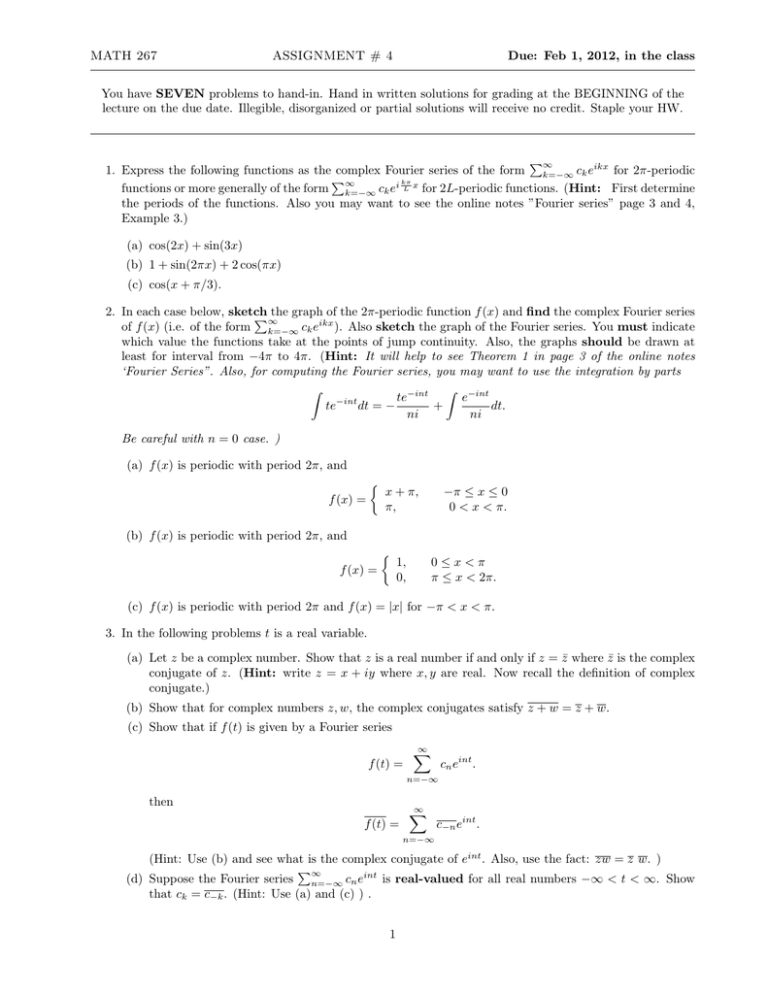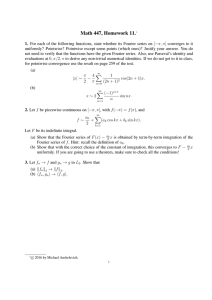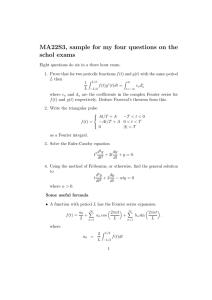Due: Feb 1, 2012, in the class MATH 267 ASSIGNMENT # 4
advertisement

MATH 267 Due: Feb 1, 2012, in the class ASSIGNMENT # 4 You have SEVEN problems to hand-in. Hand in written solutions for grading at the BEGINNING of the lecture on the due date. Illegible, disorganized or partial solutions will receive no credit. Staple your HW. P∞ 1. Express the following functions as the complex Fourier series of the form k=−∞ ck eikx for 2π-periodic P∞ kπ functions or more generally of the form k=−∞ ck ei L x for 2L-periodic functions. (Hint: First determine the periods of the functions. Also you may want to see the online notes ”Fourier series” page 3 and 4, Example 3.) (a) cos(2x) + sin(3x) (b) 1 + sin(2πx) + 2 cos(πx) (c) cos(x + π/3). 2. In each case below, sketch the graph of the 2π-periodic function f (x) and find the complex Fourier series P∞ of f (x) (i.e. of the form k=−∞ ck eikx ). Also sketch the graph of the Fourier series. You must indicate which value the functions take at the points of jump continuity. Also, the graphs should be drawn at least for interval from −4π to 4π. (Hint: It will help to see Theorem 1 in page 3 of the online notes ‘Fourier Series”. Also, for computing the Fourier series, you may want to use the integration by parts Z −int Z e te−int + dt. te−int dt = − ni ni Be careful with n = 0 case. ) (a) f (x) is periodic with period 2π, and f (x) = −π ≤ x ≤ 0 0 < x < π. x + π, π, (b) f (x) is periodic with period 2π, and f (x) = 0≤x<π π ≤ x < 2π. 1, 0, (c) f (x) is periodic with period 2π and f (x) = |x| for −π < x < π. 3. In the following problems t is a real variable. (a) Let z be a complex number. Show that z is a real number if and only if z = z̄ where z̄ is the complex conjugate of z. (Hint: write z = x + iy where x, y are real. Now recall the definition of complex conjugate.) (b) Show that for complex numbers z, w, the complex conjugates satisfy z + w = z + w. (c) Show that if f (t) is given by a Fourier series f (t) = ∞ X cn eint . n=−∞ then f (t) = ∞ X c−n eint . n=−∞ (Hint: Use (b) and see what is the complex conjugate of eint . Also, use the fact: zw = z w. ) P∞ (d) Suppose the Fourier series n=−∞ cn eint is real-valued for all real numbers −∞ < t < ∞. Show that ck = c−k . (Hint: Use (a) and (c) ) . 1 P∞ int 4. Suppose a real-valued function f (t) is given by a Fourier series for all real numbers n=−∞ cn e P∞ int −∞ < t < ∞. Recall e = cos(nt) + i sin(nt). Use this to show that the function f (t) = n=−∞ cn eint can be expressed as the trigonometric Fourier series f (t) = ∞ a0 X + an cos(nt) + bn sin(nt) . 2 n=1 You have to demonstrate how you perform each of your steps. Also, express an and bn using cn ’s for n = 0, 1, 2, 3, · · · . (Hint: You may look at page 5 and 6 in the online notes ”Fourier series”.) P∞ int 5. Suppose a real-valued function f (t) is given by a Fourier series for all real numbers n=−∞ cn e −∞ < t < ∞. Suppose in addition that f (t) is an even function. Here, f (t) is called an even function if f (t) = f (−t) for all −∞ < t < ∞. (a) Show that cn = c−n for all integer n. (Hint: what happens if t is replaced with −t in the Fourier series?) P∞ (b) Now recall eint = cos(nt) + i sin(nt). Use this to show that the even function f (t) = n=−∞ cn eint can be expressed as the Fourier cosine series ∞ f (t) = a0 X + an cos(nt). 2 n=1 You have to demonstrate how you perform each of your steps. Also, express an using cn ’s for n = 0, 1, 2, 3, · · · . (Hint: Use (a) as well as Problem 3 (d) and the result of Problem 4.) P∞ int 6. Suppose a real-valued function f (t) is given by a Fourier series for all real numbers n=−∞ cn e −∞ < t < ∞. Suppose in addition that f (t) is an odd function. Here, f (t) is called an odd function if f (t) = −f (−t) for all −∞ < t < ∞. (a) Show that cn = −c−n for all integer n. (Hint: what happens if t is replaced with −t in the Fourier series?) P∞ (b) Now recall eint = cos(nt) + i sin(nt). Use this to show that the odd function f (t) = n=−∞ cn eint can be expressed as the Fourier sine series f (t) = ∞ X bn sin(nt). n=1 You have to demonstrate how you perform each of your steps. Also, express bn using cn ’s for n = 0, 1, 2, 3, · · · . (Hint: Use (a) as well as Problem 3 (d) and the result of Problem 4 .) 7. Suppose f (t) is a real-valued 2π-periodic function on the whole real line R. Suppose f (t) is an even function, i.e. f (t) = f (−t) for all −∞ < t < ∞, and that ( 2t for 0 ≤ t < π2 , f (t) = 2(π − t) for π2 < t < π. (a) Draw the graph of f (t) on the interval −5π < t < 5π. Also, compute the (complex) Fourier series of f (t). (Hint: It will help to see Theorem 1 in page 3 of the online notes ‘Fourier Series”. Also, for computing the Fourier series, you may want to use the integration by parts Z Z −int te−int e te−int dt = − + dt. ni ni Be careful with n = 0 case. ) P∞ (b) Find the trigonometric Fourier series of f (t) of the form: f (t) = a20 + n=1 an cos(nt) + bn sin(nt) . Of course, you have to determine the coefficients an and bn . (Hint: You may want to use the results in Problem 4 or 5.) 2 8. (Do NOT hand-in this problem.) −1, 0, f (x) = 1, Let f (x) be the 2π-periodic function determined by the following: for −π ≤ x < −2π 3 and − π3 ≤ x < 0 −2π 3 −π 3 and π 3 and 2π 3 for ≤x< 0≤x< for π 3 ≤x< 2π 3 ≤x<π Draw the graph of f (x) and compute its (complex) Fourier series. 9. (Do NOT hand-in this problem.) Let f (x) be the 2π-periodic function defined on −π ≤ x < π by π + x, for −π ≤ x < 0 f (x) = π − x, for 0 ≤ x < π (a) Draw the graph of f (x) for −3π ≤ x ≤ 3π. (b) Find the Fourier series of f (x) in the complex form: f (x) = ∞ X cn einx n=−∞ (c) Find the Fourier series of f (x) in the trigonometric form (equivalently its real Fourier series): ∞ f (x) = a0 X an cos(nx) + bn sin(nx) + 2 n=1 10. (Do NOT hand-in this problem.) The temperature, u(x, t), in a metal rod of length 2L satisfies ut = uxx , −L < x < L, t > 0. The ends of the rod at x = −L and x = L satisfy the boundary conditions u(−L, t) = u(L, t) and ux (−L, t) = ux (L, t), t > 0. (a) Use the method of separation of variables to obtain the solution u(x, t) satisfying the initial condition u(x, 0) = f (x), −L < x < L. (b) Let L = π. Find the solution u(x, t) in part (a) when the rod is initially at a constant temperature u(x, 0) = π. (c) What is the limit of u(x, t) in part (b) when t → ∞? 3







